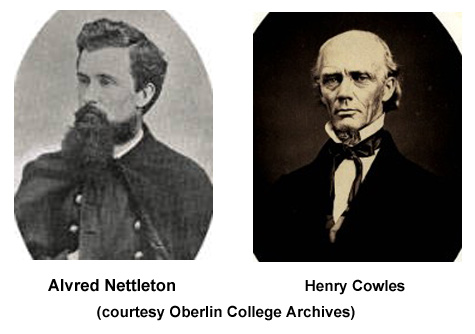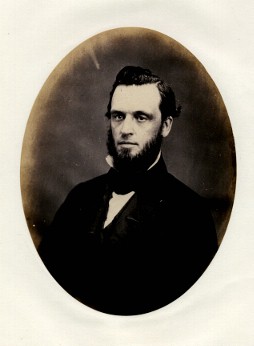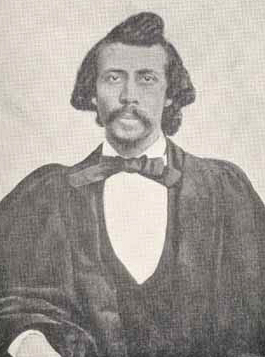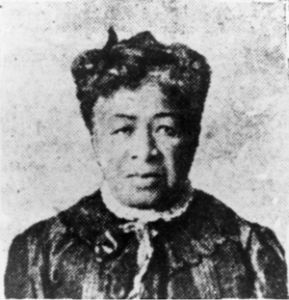Secession Concessions
Monday, May 26th, 2014by Ron Gorman, Oberlin Heritage Center volunteer docent
It was February 4, 1861, and the United States of America was coming unglued. On this date Oberlin residents gathered together to pray and discuss their response. Three months earlier the country, Oberlin included, had elected a Republican President for the first time in its history. He was Abraham Lincoln, and he ran on a platform that opposed the expansion of slavery into the national territories (the majority of land west of the Mississippi River). But just six weeks after that, South Carolina seceded from the Union, stating as a reason that the Northern states had elected a “President of the United States, whose opinions and purposes are hostile to slavery.” This was followed by Mississippi on January 9, 1861, then Florida, Alabama, Georgia, Louisiana and Texas within the next four weeks. Altogether there were 15 slaveholding states. If they all followed the lead of the Deep South states, it would likely be the end of the American Union. What to do about it was a question that vexed the nation, Ohio, and Oberlin. [1]
The delegates to Georgia’s secession convention had proposed a potential solution. On January 18, they enumerated a list of “satisfactory guarantees” that might keep them “permanently in this Union.” Among the guarantees they sought were “that Congress shall have no power to abolish or prohibit slavery in the territories.” They also insisted that “each State shall be bound to surrender fugitive slaves,” and that all states should “purge their statute books” of personal liberty laws, which were laws that had been passed by many of the Northern states to circumvent the federal Fugitive Slave Law (see my Kidnapped into Slavery blog for details). [2]
Variations of these demands were considered by numerous committees and conventions, called together to attempt to coax the seceded states back into the Union, or at least discourage more slaveholding states from joining them. But in their February 4th meeting, Oberlin residents, led by Mayor Samuel Hendry and Reverend Miner Fairfield (soon to be pastor of Oberlin’s Second Congregational Church), made it clear exactly how they felt about concessions: “we solemnly protest against any concessions to slavery, or to the demands made by the abettors in any form whatever, and especially against making such concessions at the behest of traitors in arms against the Union.” [3]
This protest was printed in both of Oberlin’s newspapers, the Oberlin Evangelist, and the Lorain County News (both published by publishers V. A. Shankland and J. F. Harmon). The Lorain County News, edited by Oberlin College student Alvred Nettleton, gave its full-fledged support to the residents’ protest, calling it “the expression of God fearing men who are imbued with an unflinching devotion to the principles of freedom.” The Oberlin Evangelist, edited by former Oberlin College professor Henry Cowles, said “there ought to be at least ten thousand such meetings held in the free North.” [4]
The Oberlin Evangelist also editorialized its own sentiments: “Concession, not compromise, is really the word now… We oppose it utterly. To make one new concession now to the demands of the Slave Power, be it ever so small, would practically break down the Federal Government.” [5] And they made it clear that their anti-concession stance extended to the Fugitive Slave Law and the personal liberty laws as well:
“It has been often intimated that the personal liberty laws of several of the Free States are the special grievance… But they cannot be repealed. They exist as the demand of our times. The Fugitive Slave Act of 1850 puts the personal liberties of free men in peril in every Free State. While that act remains in force, no Free State ought to repeal the personal liberty laws. That act provides facilities for kidnapping free men, and utterly fails to provide due safeguards for determining the great question of personal freedom.” [6]
The Lorain County News agreed: “The Fugitive Slave Act is an outrage upon rights, an arrogant imposition on enlightened consciences and a burden which is intolerable to all high minded men and women.” [7]
James Monroe(courtesy Oberlin College Archives)
So it would sound as if Oberlin was united against any compromises or concessions, right? Well, not exactly. There was at least one conciliatory voice, and ironically it came from Oberlin’s leading politician, Ohio state Senator James Monroe, a Republican abolitionist. On January 12, 1861, Monroe addressed the Ohio Senate and said:
“Civil war even now threatens us. Fortifications that were all erected by the same fraternal hands and whose thunders should never be awakened except against a common and a foreign foe, now stand frowning defiance at each other in Charleston harbor [South Carolina – Fort Sumter]… Let us then act at once, and act unitedly… let us send along the wires throughout the whole Country the firm but friendly words of these Resolutions.”
The resolutions to which he referred were a series of resolutions that he had co-authored, designed to “send words of encouragement and cheer to citizens of Slave States who are struggling to hold back States from the vortex of secession.” The “friendly” resolutions would “disclaim all right or intention to abolish slavery in the States where it exists” and “commend the course of President Buchanan in all that he has done to resist the spirit of disunion.” (For an Oberlin Republican to commend the staunchly pro-slavery Democratic President James Buchanan was quite a departure in itself!)
But another resolution was even more dramatic, although it might not appear so at first sight. Monroe proclaimed that “the Constitution and all laws made in pursuance thereof, must be carried out in all States and Territories.” As vague and innocuous as this may sound to us today, and perhaps to some of his constituents back then, it had a very specific meaning to the slaveholding states. The U.S. Constitution included a clause that required fugitive slaves to be returned to their owners, and the federal Fugitive Slave Law was one of those “laws made in pursuance thereof.” Thus this resolution was meant to convey to the slaveholding states Ohio’s support for enforcing the Fugitive Slave Law. [8]
And Monroe took it even further. He also called “for the repeal in all States of all unconstitutional enactments.” To the slaveholding states, this meant repeal of the personal liberty laws, which they considered to violate the constitutional obligation to return fugitive slaves. This was quite a stunning reversal for the man who had just five years earlier drafted and defended Ohio’s most radical personal liberty law, which had been repealed by the Democratic-controlled Ohio General Assembly after being challenged by a United States District Judge. (See my Monroe’s Personal Liberty Law blog for details.) Monroe’s about-face had to come as quite a shock to U.S. Representative Joshua Giddings from Ashtabula County, who had entreated Monroe: “If you do anything I hope and trust you will assert our rights and call on other states to do the same instead of advising them to repeal their [Personal] Liberty bills. This is no time for cowardice.” [9]
So what was up with Monroe, anyway? Was it really “cowardice”? Perhaps not. For one thing, Monroe was only one of several co-authors of these bipartisan resolutions, and he admitted that “the Resolutions are not in all respects what I would personally have preferred.” For another thing, we’ve only looked at the “friendly” resolutions so far, but as Monroe stated, there were “firm” resolutions as well. One such resolution “denounce[d] secession as impossible under our form of government”, and another one “pledge[d] the entire power and resources of Ohio to aid the Federal Government by whomsoever administered in preserving the Union in its integrity.”
Perhaps most important though is what the resolutions didn’t say. Some legislators wanted to add wording to support the “Border State Propositions”, which were a series of proposed Constitutional amendments guaranteeing support for the institution of slavery – most notably allowing its expansion into the national territories. This was a proposition that was vehemently rejected by President-elect Lincoln, who had won election on a non-expansion platform. Monroe postulated that the Ohio “Senate can never unite upon these propositions.” Per Monroe’s request, the Border State Propositions were excluded, and the resolutions Monroe advocated were passed almost unanimously by the Ohio General Assembly. [10]
So Monroe appeared willing to make concessions on the Fugitive Slave Law and the personal liberty laws, but like the Oberlin residents and newspapers, he was unwilling to concede on allowing slavery to expand into the territories. And Monroe also appeared to be taking a firm stance against secession. How did the Oberlin newspapers feel about that issue? Let’s start with the Oberlin Evangelist:
“As to the more remote future, we expect a Southern Confederacy. We do not expect concession enough from the free States to satisfy the demands of the slave States… They have in imagination a glorious ideal of the blessings of independence. They must try it in the reality…
They will have opportunity to learn how much it costs to carry on and out the system of forced labor with no help from the free States in footing their bills. This will be a new experience – we hope, instructive.” [11]
They were advocating, in the words of Horace Greeley, to “let the erring sisters go in peace”, rather than the use of force (“coercion”) to keep them in the Union. (Hey, maybe Oberlin wasn’t “the town that started the Civil War” after all!) The Lorain County News struck a similar chord:
“But as our wrath cools, we are beginning to doubt whether coercive measures are, after all, the best methods to employ against the traitors. We question whether the country would ever be compensated for the mutual hate, the pecuniary expenses and the rivers of blood which coercion would be likely to cost. We begin to see, too, that the worst punishment which could possibly be inflicted on the rampant treason would be a good letting alone, and that if the southern forts and arsenals should be given up to the traitors and their political existence should be distinctly recognized, they would soon plunge into a ruin which would be a standing warning against the danger of basing a State on injustice and cruelty.” [12]
This in fact was the anti-coercion policy of President Buchanan (who they ironically called an “imbecile” in the same article). But even President Buchanan acknowledged that secession was unconstitutional and that it would render the nation a “rope of sand, to be penetrated and dissolved by the first adverse wave of public opinion in any of the States.” [13] And of course Monroe had taken it even further when he declared that secession was “impossible under our form of government”. To this sentiment, the Oberlin Evangelist replied:
“But it is said, if secession is to be allowed, then our government is a failure. It has no power for self-preservation. It is true that our government has its limitations – it can do some things, and others it cannot do. It was designed for a free, self-governing people, intelligent in regard to their real interests and ready to accord to others what they ask for themselves. It cannot hold, by the hand of power, States or provinces of unwilling subjects. If a State refuses to be governed, our government cannot help it, and was never intended to do so. It is not adapted to a people where the barbarism of slavery exists and extends itself. Its power cannot work and control such a people, for its power must be exerted through the people themselves. Coercion might succeed, if a single insignificant State, like South Carolina, were affected with the mania of secession, with a division of sentiment within itself; but when vast sections of the Union move with a common impulse, however unjustifiable or unconstitutional the movement, we must let them go, and adjust ourselves to the new condition as we can…
Our first great danger is in compromise – our next in coercion.” [14]
Clearly there was a divide between Monroe and at least a sizable portion of his Oberlin constituency. The James Monroe of 1858 would have been more in sync with them, at least on the issue of the Fugitive Slave Law and the personal liberty laws. But Monroe, who would become the namesake of Oberlin’s “Monroe Rifles” in the ensuing civil war, had changed his tune by 1861. In fact, he was now echoing the more conservative policies of President-elect Lincoln, who he actively campaigned for in the general election and would tour the state with in the following month. If secession was to be resisted, it was wise to make some concessions and compromises to achieve as much unity as possible for prosecuting the civil war that might result. If, on the other hand, you were willing to “let the erring sisters go in peace”, as were the Oberlin newspapers (and perhaps the general Oberlin populace), no compromises or concessions were necessary.
It bears repeating, however, that all of these players were rock solid in their commitment to prevent the expansion of slavery into the national territories, which Lincoln believed would put slavery on “the course of ultimate extinction”. And on April 12, 1861, when the Confederates bombarded Fort Sumter, these men were all united behind the United States soldiers who would fight to put down the rebellion. (See our “Lorain on Fire!! War Spirit at Oberlin!!!” blog for details on how these leading Oberlinites reacted.)
Five years later, when the dust, smoke and fog of civil war finally cleared, it would appear that the Oberlin Evangelist had been prophetic as to the end result, even though they didn’t envision the means by which it would be achieved: “It is so plain that even wayfaring men can see it – that God is preparing to use secession as a battering ram upon the entire system of American Slavery.” – The Oberlin Evangelist, January 2, 1861 [15]
(If you would like to hear more about the controversy over the Fugitive Slave Law and Monroe’s personal liberty law, especially as it related to Oberlin, please join me and the Oberlin Heritage Center at the Heiser Auditorium at Kendal at Oberlin, at 7:15 PM, Tuesday, June 3rd, for a presentation commemorating the 150th anniversary of the repeal of the Fugitive Slave Law.)
SOURCES CONSULTED:
“Remarks of Mr. Monroe”, The Lorain County News, Vol 1, No. 48, page 1, January 30, 1861
“Prayer and Protest”, The Oberlin Evangelist, Feb 13, 1861, p. 31
“Protest”, The Lorain County News, February 6, 1861
“Are We Disunionists?”, The Lorain County News, February 6, 1861
“The Great Crisis. Secession”, The Oberlin Evangelist, Jan 2, 1861, p. 5
“Coercion”, The Oberlin Evangelist, Jan 30, 1861, pp. 22-23
“The Future of these once United States, and the Duty of the Hour”, The Oberlin Evangelist, Jan 30, 1861, p. 22
“Compromise and Concession”, The Oberlin Evangelist, Feb 13, 1861, p. 28
“What is the Federal Union Worth?”, The Oberlin Evangelist, Jan 2, 1861, p. 7
Catherine M. Rokicky, James Monroe: Oberlin’s Christian Statesman & Reformer, 1821-1898
“Declaration of Causes of Seceding States“, The American Civil War Homepage
Roy Franklin Nichols, The Disruption Of American Democracy
President James Buchanan, “Fourth Annual Message” (December 3, 1860)
“The Border State Convention”, The Lorain County News, February 6, 1861
“Shall the Impending War be a Good or an Unmitigated Evil?”, The Oberlin Evangelist, Apr 24, 1861, p. 70
George Frederick Wright, A Standard History of Lorain County, Ohio
Robert Samuel Fletcher, A History of Oberlin College
“Republican Party Platform of 1860“, The American Presidency Project
FOOTNOTES:
[1] “Declaration”
[2] “Journal”
[3] “Prayer”
[4] “Protest”; “Prayer”
[5] “Compromise”
[6] “The Great Crisis”
[7] “Are We Disunionists?”
[8] “Remarks”
[9] “Remarks”; Rokicky, p. 63
[10] “Remarks”; Nichols, p. 456; Rokicky, p. 64
[11] “The Future”
[12] “Are We Disunionists?”
[13] Buchanan
[14] “Coercion”
[15] “What is the Federal Union Worth”










